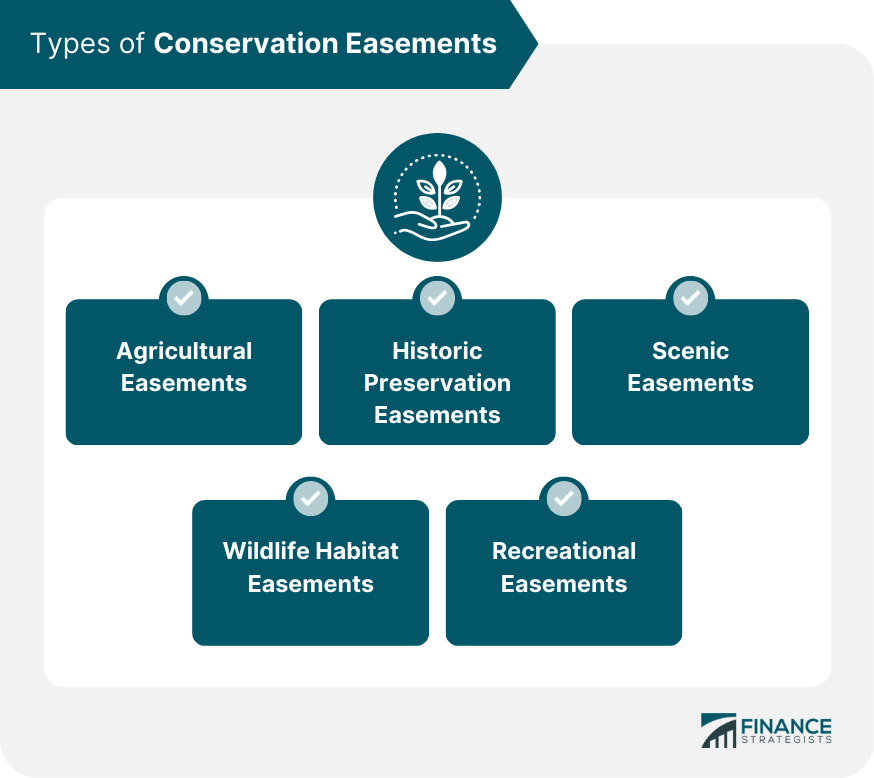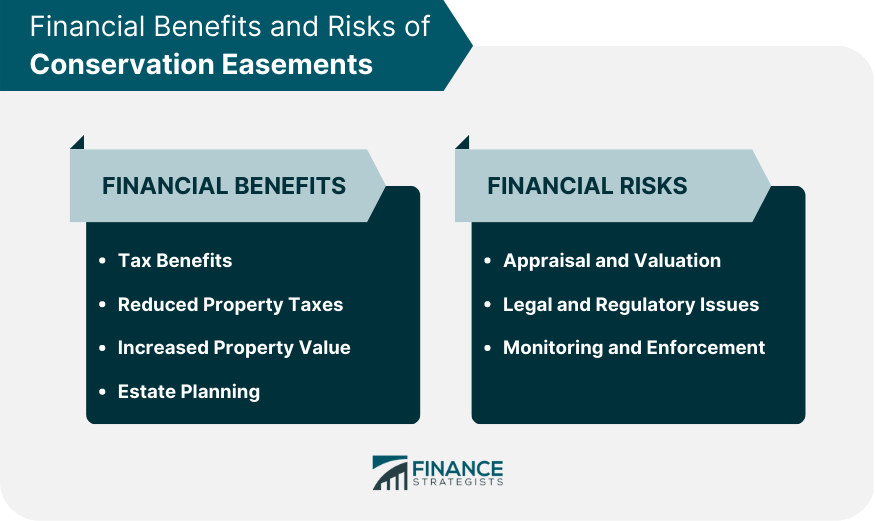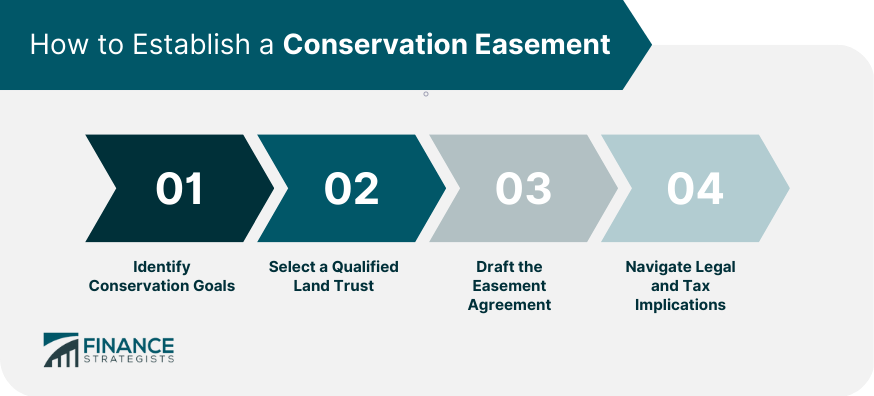Conservation easements are voluntary, legally-binding agreements between landowners and land trusts or government entities. These agreements restrict certain land uses while protecting the land's conservation values. In financial terms, it can be seen as a method for landowners to preserve land while receiving financial benefits. Conservation easements help preserve natural habitats, agricultural lands, and historical sites for future generations. Conservation easements play a critical role in land preservation efforts. Conservation easements play a crucial role in finance by offering landowners tax benefits, reduced property taxes, and other financial incentives. They help support the conservation of valuable land while providing financial advantages for both landowners and investors. Different types of conservation easements address various conservation needs and land uses. This section will discuss the most common types of easements. Agricultural easements help protect valuable farmland from development and other incompatible uses. These easements preserve agricultural land for food production and support rural economies. They also maintain the scenic beauty of rural landscapes. Historic preservation easements safeguard historically significant properties or sites. These agreements protect the unique character and cultural value of historic structures, landscapes, or archaeological sites. Scenic easements preserve the visual quality of open spaces, viewsheds, or landscapes. They help maintain the aesthetic beauty of natural and cultural resources, promoting tourism and community pride. Wildlife habitat easements protect crucial habitats for endangered or threatened species. These agreements preserve biodiversity and support the health of ecosystems. They also contribute to the overall well-being of the environment and wildlife populations. Recreational easements grant public access to private lands for outdoor activities such as hiking, fishing, or birdwatching. These agreements promote health and well-being by encouraging people to enjoy nature. They also foster an appreciation for conservation and environmental stewardship. Landowners who donate a conservation easement may qualify for federal income tax deductions. This benefit helps to offset the loss of development rights and provides a financial incentive for landowners to preserve their property for future generations. Conservation easements can lower property taxes by reducing the assessed value of the land. As the land's development potential is limited, the taxable value decreases, providing financial relief for the landowner. While a conservation easement may limit development options, it can increase the value of neighboring properties. By preserving natural resources and maintaining the area's character, landowners may see an increase in the overall value of their property. Conservation easements can play a significant role in estate planning, allowing landowners to pass on a legacy of land conservation. They can also reduce estate taxes, ensuring that heirs can afford to maintain the property's conservation goals. Determining the value of a conservation easement can be challenging due to the unique characteristics of the land. Appraisers must carefully evaluate the land's development potential, conservation goals, and market conditions to provide an accurate valuation. Conservation easements involve complex legal agreements, which may require the assistance of experienced legal professionals. Landowners must navigate federal, state, and local regulations to ensure compliance and avoid potential disputes. Land trusts and government agencies are responsible for monitoring and enforcing conservation easements. This task can be challenging and resource-intensive, requiring ongoing commitment and funding to ensure the land's continued preservation. Creating a conservation easement involves several steps. This section will discuss the process of establishing an easement, from setting conservation goals to navigating legal and tax implications. Identify Conservation Goals Before establishing an easement, landowners must identify their conservation goals. These goals may include preserving wildlife habitat, maintaining agricultural land, or protecting a historic site. Landowners should work with a reputable land trust or government entity to create a conservation easement. These organizations can provide guidance and expertise throughout the process. They also help ensure that the easement aligns with the landowner's conservation goals and complies with legal requirements. Once conservation goals are set and a land trust is selected, the parties work together to draft the easement agreement. This document outlines the specific restrictions and permitted uses of the land. It is crucial to carefully craft the agreement to meet the unique needs of the property and the conservation goals. Conservation easements have legal and tax implications for landowners. It is essential to consult with legal and financial advisors to understand the easement's potential impact on property rights, taxes, and estate planning. Proper planning can ensure that the easement benefits both the landowner and the environment. Federal, state, and local governments often provide funding for conservation easements through various programs. These programs may offer grants, tax incentives, or other financial support to landowners and organizations seeking to preserve land. Non-profit organizations, such as land trusts, play a vital role in the conservation easement process. They often secure funding from private donations, foundations, and government grants to facilitate land conservation efforts. Private investors can also provide funding for conservation easements, recognizing the financial and environmental benefits of land preservation. Investment in conservation easements can offer both financial returns and positive environmental impacts. Conservation easements are voluntary legal agreements between landowners and land trusts or government agencies that protect land while offering financial benefits. There are two types of conservation easements: perpetual and term. Financial benefits include tax deductions, reduced property taxes, increased property value, and estate planning advantages. However, risks and challenges include appraisal and valuation, legal and regulatory issues, and monitoring and enforcement. Conservation easements play an essential role in finance, offering landowners various financial incentives while supporting the preservation of valuable land. This creates a balance between economic development and environmental conservation, benefiting both landowners and investors. By understanding the different aspects of conservation easements, stakeholders can make informed decisions about land use and investment, ultimately promoting sustainable land management practices for generations to come. Emerging technologies and innovative approaches may shape the future of conservation easements. For example, remote sensing technology and geographic information systems (GIS) can help monitor and manage protected lands more effectively. Additionally, new models of collaboration and partnership among land trusts, landowners, and local communities could enhance the success of conservation efforts. Greater public awareness and support for conservation easements will be essential for their continued success. Education and outreach efforts can help highlight the benefits of easements and encourage landowners to consider this valuable conservation tool. As more people understand the importance of land preservation, conservation easements may become an increasingly popular and effective means of protecting valuable natural and cultural resources.What Are Conservation Easements?
Types of Conservation Easements
Agricultural Easements
Historic Preservation Easements
Scenic Easements
Wildlife Habitat Easements
Recreational Easements

Financial Benefits of Conservation Easements
Tax Benefits
Reduced Property Taxes
Increased Property Value
Estate Planning
Risks of Conservation Easements in Finance
Appraisal and Valuation
Legal and Regulatory Issues
Monitoring and Enforcement

Establishing a Conservation Easement
Select a Qualified Land Trust
Draft the Easement Agreement
Navigate Legal and Tax Implications

Funding for Conservation Easements
Government Programs
Non-profit Organizations
Private Investors
Final Thoughts
Conservation Easements FAQs
Conservation easements are legal agreements that limit the type and amount of development that can take place on a property in order to preserve its natural resources, cultural heritage, or scenic value.
Conservation easements can provide significant tax benefits to property owners, including income tax deductions and property tax reductions. In some cases, conservation easements can also increase the value of a property.
Any landowner who donates a conservation easement to a qualified organization, such as a land trust or government agency, may be eligible for tax benefits. However, the specific benefits will depend on a number of factors, including the type of easement and the property's value.
Conservation easements can be funded through a variety of sources, including government grants and programs, private donations, and partnerships between nonprofit organizations and private landowners.
Some of the key risks and challenges of conservation easements include the difficulty of valuing the easement, potential legal and regulatory issues, and the need for ongoing monitoring and enforcement to ensure compliance with the easement terms.
True Tamplin is a published author, public speaker, CEO of UpDigital, and founder of Finance Strategists.
True is a Certified Educator in Personal Finance (CEPF®), author of The Handy Financial Ratios Guide, a member of the Society for Advancing Business Editing and Writing, contributes to his financial education site, Finance Strategists, and has spoken to various financial communities such as the CFA Institute, as well as university students like his Alma mater, Biola University, where he received a bachelor of science in business and data analytics.
To learn more about True, visit his personal website or view his author profiles on Amazon, Nasdaq and Forbes.











